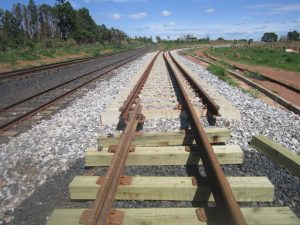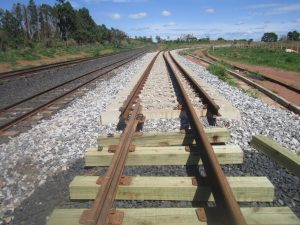Railroads Drive Expansion of Soybean Cultivation in Brazil’s Amazon Region
 29 Agustus 2021
29 Agustus 2021

In Anapolis, Brazil’s North-South railway line, which took more than 30 years to complete, was unable to connect with the existing network due to the different width of its tracks and its southern section remained inactive for several years, until it was privatised in 2019. Precedents like this one create concern about the new planned railway lines, dedicated to the transportation of grains to the export ports. CREDIT: Mario Osava
By Mario Osava
RÍO DE JANEIRO, Aug 27 2021 (IPS)
The sea of soybeans that sprouts every November will spread even further in the state of Mato Grosso if three new railway lines that would boost soy production in central-western Brazil and growing parts of the Amazon rainforest are built.
The most controversial railway line, the EF-170, is better known by its nickname “Ferrogrão (grainrail)” because it is to be built for the export of grains from the mid-northern part of Mato Grosso, the area where most soybeans and corn are produced in Brazil, through Amazonian rivers and ports in the north of the country.
Mato Grosso already produces 70 million tons of grains per year, a total that will reach 120 million tons by 2030, said Minister of Infrastructure Tarcisio de Freitas, who described the Ferrogrão as “the most important logistics project in Brazil,” in a digital meeting with foreign correspondents in June.
It would lower freight rates in general, by creating competition in the transportation of the bulk of the national agricultural production, replacing thousands of trucks and expanding exports through the ports of northern Brazil, relieving pressure on ports in the south and southeast.
The government intended to auction the concession for the rail line this year, but is unlikely to do so in the face of environmental obstacles and economic uncertainties.
The railway would cause the deforestation of between 1,671 and 2,416 square kilometres by stimulating the expansion of the planted area in the state of Mato Grosso alone, according to a study by the Climate Policy Initiative (CPI), an international non-profit organisation with which the Pontifical Catholic University of Rio de Janeiro is associated.
The study does not take into account damage in the state of Pará, where two thirds of the 933 kilometres of the line would be built and where the port of Miritituba on the Tapajós River, the railway’s destination, is located.

In Brazil’s Amazon region, the EF-170 railroad, known as Ferrogrão, is a project of agricultural transnationals supported by the Brazilian government. The aim of the railway, construction of which has not yet begun, is to bolster soybean and corn exports through the ports of northern Brazil. Map: National Land Transport Agency of Brazil
At the port, grains are transferred to barges that travel about 1,000 kilometres on the Tapajós and Amazon rivers to reach the export ports where the large transatlantic ships dock.
In addition to underestimating the extent of the deforestation, the project would violate indigenous rights, threaten conservation areas and stimulate illegal land appropriation, says a group of 38 social organisations in an “extrajudicial notification” to banks that could finance the construction of the Ferrogrão.
“The most serious thing is that it does not evaluate alternative routes,” said Sergio Guimarães, coordinator of the Infrastructure and Social Justice Working Group, a coalition of 47 organisations that headed the notification pointing out nine flaws in the project. (The Working Group is one of the 38 social organisations that sent the notification.)
There are alternatives for transportation already in place or under way for soybeans in Mato Grosso, where 35.9 million tons were produced this year (26.5 percent of the country’s total), such as the BR-163 highway along the same route as the Ferrogrão, a railroad under construction and two others in the planning stage. They should all be assessed in order to find the best economic and environmental options, he told IPS by telephone from Brasilia.
“It is very difficult for the Ferrogrão to be competitive, considering that the BR-163 highway is already in place and there are other alternatives,” said economist Claudio Frischtak, president of the InterB International Business Consultancy.
“It’s a bad project,” he told IPS in a conversation in Rio de Janeiro. “It underestimates the investments and the time needed for implementation and runs the risk of having the same fate as two other railroads whose construction was interrupted in the last decade, leading to the loss of public resources.”

The state of Tocantins in central Brazil aims to repeat this century the soybean boom that transformed the neighbouring state of Mato Grosso, the country’s largest soy and corn producer, which has record exports. To do this, producers are demanding the extension of rail transport. CREDIT: Mario Osava/IPS
The economist compared the data from the government’s proposal with figures from the Midwest Integration Railway (Fico), a project under construction by the mining company Vale, which has years of experience in railways. Fico will link Agua Boa, a city in central-eastern Mato Grosso, and Mara Rosa, 383 kilometres to the east, in the state of Goiás.
Based on this comparison, Frischtak calculates that the actual cost of building the Ferrogrão would be 3.4 times the amount reported by the government: 5.45 billion dollars rather than 1.58 billion dollars.
The projected rate of return of 11.05 percent is also totally unrealistic, he said, as is the estimated construction time of nine years.
Frischtak projected that construction would actually take 21.9 years, or even longer given the complicated terrain where the Ferrogrão would be built.
The Fico does not reach the most productive soybean production area, which is around the city of Sinop, the planned starting point of the Ferrogrão. Instead, it connects with the North-South Railway that reaches the port of Itaqui, on the Atlantic coast of the northeastern state of Maranhão, which has the capacity to serve the largest ships.
The third new rail alternative for grains in Mato Grosso is the Ferronorte, a 730-kilometre stretch planned by Rumo, the largest national railroad transportation company, with access to the Port of Santos, the country’s biggest, after crossing the state of São Paulo, the most densely populated productive, agricultural and industrial state in Brazil.

The large warehouses next to the BR-163 highway, used by trucks to transport soybeans to the Amazon ports through which they are exported, have turned Lucas do Rio Verde into a hub of the agro-export economy of the state of Mato Grosso, in central-western Brazil. CREDIT: Mario Osava/IPS
Rumo’s rail network already reaches Rondonópolis, in the south of Mato Grosso. The idea would be to extend it to the mid-north of the state, where large quantities of soybeans are produced between October and February, and corn in the following months, on the same land. Agriculture in tropical climates has the competitive advantage of producing two harvests per year.
But the biggest competition for the Ferrogrão, according to Frischtak, would be the BR-163 highway, the paving of which was completed in 2019. Management of the highway was awarded to a private company this year. Overland trucking costs fell and continue to decline, which will hinder the financial viability of the new parallel rail line.
The economist argued that it would make more economic sense to upgrade existing infrastructure, such as widening the highway and improving the waterways that also serve agricultural exports through the north. “We must not continue to make the same mistakes,” he said.
But Tiago Stefanello Nogueira, coordinator of Agricultural Policy and Logistics of the Association of Soybean and Corn Producers of Mato Grosso (AprosojaMT), said there is no doubt about the viability and benefits of the Ferrogrão.
“There will be less pollution, because it will reduce the consumption of petroleum derivatives, greater transportation capacity, less carbon emissions and thousands of jobs created during construction, as well as demand for services; there are many benefits,” he asserted.

Railroads are mostly used for freight transport in Brazil, and passenger trains like this one on the Carajás line in Maranhão state often run at a loss, as compensation for the local populace from the companies that control the rail lines. CREDIT: Mario Osava/IPS
Only 11 percent of the land in Mato Grosso is dedicated to agriculture, according to Aprosoja, and this could expand to 40 percent, Nogueira estimates.
“To achieve this we need all modes of transportation, whether railways, highways and future waterways, and the paving and widening of roads,” he told IPS by telephone from Sorriso, a city located in a soybean-growing area in the north of the state.
But that’s the problem, according to Alexandre Sampaio, Policy and Programme coordinator of the International Accountability Project (IAP), an international organisation that works for human and environmental rights in development. He said Ferronorte would exacerbate the already unbalanced development model in its area of influence.
Of the 90.3 million hectares in Mato Grosso, 9.7 million are under agricultural production. That includes nine million hectares where soybeans are grown and then corn and cotton after the soybean harvest. The remaining 0.7 million hectares are dedicated to other agricultural activities, according to Aprosoja.
In other words, even though the state of Mato Grosso is known as a huge breadbasket, it produces abundant agricultural production for export but little food, which it has to buy from other regions. In fact, only 18 percent of the state´s population is rural.
Although it is intended to be used for export agriculture, “the railroad is a great investment that drives up the value of the land, boosts the economy and wealth, in addition to reducing traffic on the roads. In other words, it indirectly benefits family agriculture,” said Nilton Macedo, president of the Federation of Agricultural Workers of Mato Grosso.
“We have 148,000 members, 97,000 of whom were resettled as part of the agrarian reform programme,” he told IPS by telephone from Pontes e Lacerda, in the southeastern part of the state. The federation says it represents 500,000 workers, including wage-earning farmworkers and family farmers who work their own land.
In contrast, soybean and corn producers number only 7,300, according to Aprosoja, but they dominate the state’s economy.
